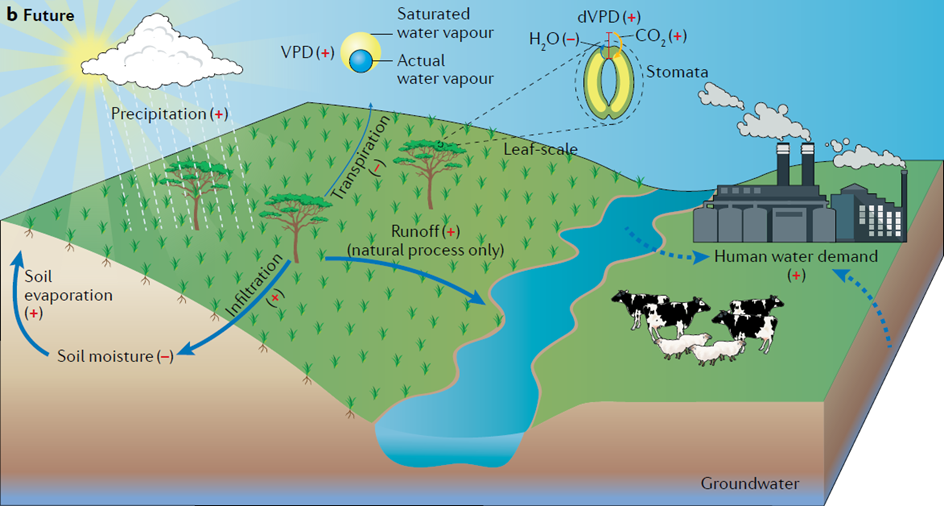Peking University, March 11, 2021: Global drylands are experiencing faster-than-average warming and are also among the most vulnerable regions to climate change. Meteorological metrics all point to an emerging trend of increased surface aridity, raising concerns of land desertification and degradation. However, recent satellite observations also show lusher drylands, in apparent contradiction to the image of drylands becoming drier. In a new Review Article published in Nature Reviews Earth & Environment, an international team comprehensively examined global dryland aridity changes with evidence from the literature and various sources of Earth observations and numerical modeling. A key message of this synthesis is that, by considering the physiological effect of rising atmospheric carbon dioxide (CO2), the apparent paradox between enhanced surface aridity and lusher dryland vegetation can actually be resolved.

Figure 1: Future aridity changes of atmospheric, ecohydrological, and socio- economic systems over drylands.
Led by researchers from Peking University, the team includes scientists with diverse expertise on global dryland research from China, UK, France, Australia, USA and Austria. By employing a broad range of aridity metrics, the team provided a more complete picture of current and future aridity changes over global drylands. They found that atmospheric-based metrics generally show a strong trend of rising dryness; while soil moisture and runoff also imply increasing dryland aridity, yet at slower paces. By contrast, ecosystem-based metrics show a trend of greening and reduced plant water stress, despite the rising atmospheric dryness. The co-occurrence of atmospheric drying and ecosystem greening over drylands is also confirmed by model simulations of vegetation dynamics.
Lian Xu from Peking University, the lead author of this study, explains: “Literally, aridity means insufficient water supply to meet the demand. However, for different parts of the land surface, their supply and demand sides are different; and they can move in divergent directions under environmental change. Therefore, when different dryness metrics are brought together in a unified framework, they can have very different trends”. He further added: “No single metric fully captures the complex nature of the land surface aridity”.
Higher temperatures increase atmospheric demand for water, and are expected to aggravate plant water stress. However, dryland plants are found to experience reduced levels of water stress thanks to the simultaneously increasing concentration of atmospheric CO2. This is because the pores of plant leaves (stomata), which allow for water loss through a process called transpiration, partially close under higher CO2 concentrations, conserves water under increasing aridity. For water-stressed ecosystems, the saved water allows plants to capture extra CO2 and thus trigger more vigorous growth (greening). The reduced plant transpiration also impacts other land surface processes, leaving more water stored in soils and running off through rivers, but at the same time also making the near-surface air warmer and drier.
“It is always tempting to define the water stress plants will feel under climate change by the new weather regimes they might experience. Our research shows that ignoring vegetation physiological response gives an incomplete picture, as the capability to adjust to drier conditions is stronger than expected”, said Chris Huntingford from the UK Centre for Ecology and Hydrology.
The authors note that future changes to drylands may be highly nonlinear, and subject to additional drivers such as flash droughts, fire disturbances and intensification of human activities, which are not yet fully understood. “Understanding possible nonlinear behaviors and tipping points of dryland ecosystem changes, and improving their representation in Earth system models, is a high priority for future research”, Lian added.
In the future, the rapidly growing populations and socio-economic development in drylands may increase human water demand dramatically, which will become the key driving force of dryland aridity changes, competing with ecosystems for water and posing a growing threat to ecosystem health. “Dryland water-resource management and climate-change mitigation policies should consider how to manage water in more efficient and sustainable ways, to safeguard food security while simultaneously maintain healthy ecosystems”, said Fu Bojie of the Chinese Academy of Sciences, who leads the Global Dryland Ecosystem Programme (Global-DEP) aiming to facilitate dryland social-ecological sustainability.
Full paper reference: Lian, X. et al. Multifaceted characteristics of dryland aridity changes in a warming world. Nature Reviews Earth & Environment (2021).
https://www.nature.com/articles/s43017-021-00144-0.